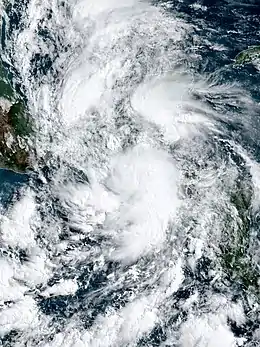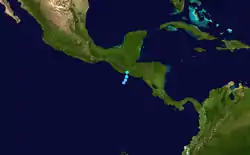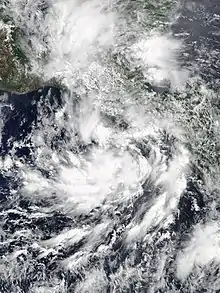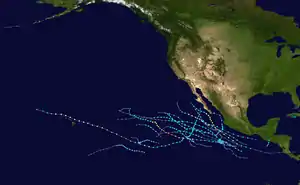Tropical Storm Amanda (2020)
Tropical Storm Amanda was a short-lived but devastating tropical cyclone that is regarded as the worst natural disaster in El Salvador since Hurricane Mitch in 1998. Amanda caused deadly flooding and landslides across Central America and Mexico in late-May 2020 that killed 40 people. The second tropical cyclone and first named storm of the 2020 Pacific hurricane season, Amanda developed out of a broad area of low pressure associated with a tropical wave, that moved off the coast of Nicaragua on May 26. The disturbance slowly developed a more well defined circulation and on May 30, and the system was designated as Tropical Depression Two-E. Originally expected not to significantly strengthen, nevertheless it compacted and was upgraded to Tropical Storm Amanda at 09:00 UTC the next day. Three hours later, Amanda made landfall in southeast Guatemala, the first tropical cyclone to make landfall along that nation's Pacific coast since Tropical Storm Agatha in 2010. Once inland, Amanda rapidly weakened and degenerated into a remnant low over the region's rough terrain. However, the system's remnants survived, crossing Central America and Mexico and re-organized into Tropical Storm Cristobal in the Atlantic.
| Tropical storm (SSHWS/NWS) | |
 Tropical Storm Amanda shortly after landfall in Guatemala on May 31 | |
| Formed | May 30, 2020 |
|---|---|
| Dissipated | May 31, 2020 |
| Highest winds | 1-minute sustained: 40 mph (65 km/h) |
| Lowest pressure | 1003 mbar (hPa); 29.62 inHg |
| Fatalities | 40 total |
| Damage | ≥ $200 million (2020 USD) |
| Areas affected | Central America (particularly Guatemala and El Salvador), Mexico |
| Part of the 2020 Pacific hurricane season | |
Amanda caused torrential rainfall across Guatemala and El Salvador, the latter of which was heavily impacted by the storm. In Guatemala, 1,500 shelters were opened for survivors. In El Salvador, rivers overflowed and swept away buildings, damaging 900 homes and displacing over 1,200 people. This forced temporary movement restrictions put in place for the ongoing COVID-19 pandemic to be lifted. Combined rainfall from Amanda and Cristobal caused well over 15 inches of rain in some places, peaking at 26.48 inches in Jutiapa, Guatemala. Heavy rains also caused minor to moderate flooding in Mexico and Belize. Impacts from Amanda were also felt in Honduras, where five people were killed. Overall, Amanda resulted in an estimated $200 million in damage and killed 40 people in three countries.[1]
Meteorological history

On May 24, the NHC first discussed the possibility of tropical cyclogenesis in the East Pacific basin due to a broad area of low pressure that was forecast to form off the coast of El Salvador with an associated tropical wave.[2][3] Furthermore, several other factors went into the formation of Amanda, most notably a Kelvin wave traversing east over the far eastern portion of the basin and a mid-upper level low forming off the coast of Mexico, both enhancing large-scale convective activity.[3] A tropical wave tracked generally westward across the Atlantic basin for several days, crossing over Panama and entering the Eastern Pacific basin on May 29.[3] As the tropical wave emerged, it caused the pre-existing disturbance that was enhanced by a Central American gyre to become more organized.[3][4]
By May 30, the system attained a closed and defined low-level circulation and was considered sufficiently organized enough to be designated as Tropical Depression Two-E later that same day, remaining embedded within the eastern side of a Central American gyre.[5] The depression slowly intensified to a strength of 35 mph (55 km/h) in aid of fairly warm sea surface temperatures,[6] and at the time was considered unlikely to intensify further.[6] The depression shifted northeastward than north-northeastward as it remained entrained into the larger gyre's circulation.[3] The depression further strengthened to tropical storm strength and earned the name Amanda at 06:00 UTC May 31, as based from an improving satellite appearance.[3] Amanda improved further in organization up to landfall at 10:00 UTC that day near Las Lisas, Guatemala.[3] Amanda's appearance quickly deteriorated over land due to the mountainous landscape, and its low-level circulation center dissipated at 18:00 UTC on May 31.[3] However, Amanda's remnant low survived the land interaction.[7] The remnants of Amanda continued to move northwestward, eventually emerging into the Bay of Campeche in the Atlantic basin and leading to the formation of Tropical Depression Three on June 1, which later became Tropical Storm Cristobal.[3]
Preparations and impact
Guatemala

On May 31, Amanda made landfall in Guatemala,[8] only the second tropical cyclone to make landfall on that nation's Pacific coast this century. The last to do so was Tropical Storm Agatha in 2010.[9] The government of Guatemala issued a tropical storm warning for the entire coastline of Guatemala, from the Guatemala–Mexico border eastward to the El Salvador–Guatemala border.[10] In Guatemala, nearly 1,500 shelters were opened for those affected by the storm.[9] Two people died across the country.[11]
El Salvador

In El Salvador, torrential rainfall caused significant damage along coastal cities in the country as rivers overflowed and swept away buildings.[12] 25% of the country's annual rainfall totals fell in just 70 hours due to Amanda.[13] Rainfall reached 267.4 mm (10.53 in) in Izalco by the morning of May 31, prior to Amanda's landfall.[14] Amanda killed 27 people in El Salvador,[15] of which at least six died due to flash flooding, and one died from a collapsed home.[16] Seven people remain missing as of June 2.[17] More than 900 homes were damaged across the country and 1,200 families were evacuated to 51 shelters across La Libertad, San Salvador, Sonsonate, and San Vicente. In the capital, San Salvador, 50 houses were destroyed and 23 vehicles fell into a sinkhole.[18][19] El Salvador President Nayib Bukele declared a 15-day national state of emergency due to the storm.[16] Movement restrictions in place for the ongoing COVID-19 pandemic were temporarily lifted to allow people to purchase medicines, while hardware stores were allowed to open with limited capacity so people could purchase equipment for repairs.[18] Around 7,225 people lost their homes and had to be sent to 154 shelters around the country.[20] At least 2,800 hectares of crops were damaged or lost in the country.[21] Additionally, around 30,000 structures were damaged or likely destroyed by flooding and mudslides.[22] Amanda was considered the worst weather disaster to effect El Salvador in 22 years since Hurricane Mitch, in which Amanda caused rainfall accumulations of at least 600 mm (23.62 in) in many parts of the country and Mitch only caused at least 400 mm (15.74 in) in other areas in a longer period of time.[23] Around 336,000 Salvadorans were pushed into severe food insecurity in both rural and urban areas.[24]
ACT Alliance promised at least US$75,000 worth of food and other emergency supplies to be supplied to 1,450 households across the country.[25] Damage was estimated at US$200 million (1.75 billion colón).[26][27][28]
Honduras
Despite being located relatively far away from Amanda's point of landfall, five people died in Honduras due to the storm, including a brother and sister whose car was swept away by a current in Tegucigalpa. Heavy flooding affected the Valle Department in the west of the country. Maximum precipitation from Amanda was reported in the extreme southwest of Honduras, near the El Salvador border, where 9-day rainfall totals from Amanda and Cristobal peaked between 500–600 millimetres (20–24 in).[3]
See also
- Tropical cyclones in 2020
- Other tropical cyclones named Amanda
- List of Eastern Pacific tropical storms
- Tropical Storm Alma (2008) – Also impacted El Salvador
- Tropical Storm Agatha (2010) – caused catastrophic flooding in Central America, particularly Guatemala
- Tropical Storm Hermine (2010) – Atlantic tropical storm that formed from the remnants of Pacific Tropical Depression Eleven-E
- Tropical Storm Selma (2017) – Also impacted El Salvador and Guatemala
References
- AFP (June 3, 2020). "Tropical Storm Amanda death toll rises to 26 in Central America". RTL. Retrieved June 22, 2020.
- "NHC Graphical Outlook Archive May 24, 2020". www.nhc.noaa.gov. Retrieved 2020-05-31.
- Berg, Robbie (September 10, 2020). Tropical Cyclone Report: Tropical Storm Amanda (PDF) (Report). National Hurricane Center. Retrieved December 27, 2020.
- NHC_TAFB (2020-05-30). "May 30 10AM: A Central American Gyre over the eastern Pacific and northern Central America is producing large clusters of thunderstorms. These thunderstorms will continue to occur over Nicaragua, Honduras, El Salvador, Belize, and southeastern Mexico thru next week (1/2)pic.twitter.com/biwz3Ka9fc". @NHC_TAFB. Retrieved 2020-05-31.
- Cangialosi, John. "Tropical Depression TWO-E Forecast Discussion Number 1". www.nhc.noaa.gov. Retrieved 2020-05-31.
- Beven, Jack. "Tropical Depression TWO-E Forecast Discussion 2". www.nhc.noaa.gov. Retrieved 2020-05-31.
- Berg, Robbie (January 13, 2021). Tropical Cyclone Report: Tropical Storm Cristobal (PDF) (Report). National Hurricane Center. Retrieved January 20, 2021.
- "Tropical Storm AMANDA Intermediate Advisory Number 3A". www.nhc.noaa.gov. Retrieved 2020-05-31.
- Kelley, Maura (June 2, 2020). "Amanda leaves destructive flooding in El Salvador, Guatemala". accuweather.com. Retrieved June 22, 2020.
- "Tropical Depression Two-E Advisory 1". nhc.noaa.gov. Retrieved 2020-06-01.
- "Tormenta tropical "Amanda" deja 26 muertos en Centroamérica". Diario Las Américas (in Spanish). June 3, 2020. Retrieved June 3, 2020.
- "La tormenta tropical Amanda provoca inundaciones y el desbordamiento de ríos en El Salvador". Noticias de El Salvador - elsalvador.com (in Spanish). 2020-05-31. Retrieved 2020-05-31.
- "Appeals - IFRC". www.ifrc.org. Retrieved 2020-06-29.
- Ministerio de Medio Ambiente [@MedioAmbienteSV] (May 31, 2020). "#ElObservatorioInforma 4:35 a.m. Lluvia máxima registrada en las zonas occidental, central, paracentral y oriental del país. PO" (Tweet) (in Spanish). Retrieved May 31, 2020 – via Twitter.
- "Al menos 27 personas ya han muerto en El Salvador a causa de las lluvias" (in Spanish). Noticiero Telemundo. June 4, 2020. Retrieved June 4, 2020.
- "Alerta Roja por lluvias: Tormenta tropical Amanda deja al menos siete fallecidos y severas inundaciones en El Salvador". Noticias de El Salvador - La Prensa Gráfica | Informate con la verdad (in Spanish). Retrieved 2020-05-31.
- "Más de 24 mil familias afectadas, 16 fallecidos y 7 desaparecidos tras tormenta Amanda". Channel NewsAsia (in Spanish). June 3, 2020. Retrieved June 3, 2020.
- "Hurricane Amanda kills 14 people in El Salvador". Seven News. June 1, 2020. Retrieved June 1, 2020.
- "Deadly Tropical Storm Amanda hits El Salvador, Guatemala". Channel NewsAsia. Agence France-Presse. June 1, 2020. Retrieved June 1, 2020.
- "ACT Rapid Response Fund: Emergency Response to Tropical Storm Amanda in El Salvador (RRF 05-2020) - El Salvador". ReliefWeb. Retrieved 2020-06-29.
- "Impact Snapshot: Tropical Storm Amanda and Tropical Storm Cristobal As of 8 June 2020 - El Salvador". ReliefWeb. Retrieved 2020-06-29.
- "Storm Amanda is the last straw for families in El Salvador amid COVID-19 | MSF". Médecins Sans Frontières (MSF) International. Retrieved 2020-06-29.
- "UNICEF El Salvador Humanitarian Situation Report No. 1 (Tropical Storm Amanda) - 31 May-10 June 2020.pdf" (PDF). ReliefWeb. June 4, 2020.
- "Tropical Storm Amanda severely impacts food security of 340,000 Salvadorans | World Food Programme". www.wfp.org. Retrieved 2020-06-29.
- "Tropical Storm Amanda El Salvador RRF 05-2020". Actalliance. June 22, 2020. Retrieved December 27, 2020.
- "Global Catastrophe Recap - May 2020" (PDF).
- Lessner, Justin (2020-06-03). "Tropical Storm Leaves At Least 20 Dead In El Salvador And Now Threatens The U.S. Gulf Coast". we are mitú. Retrieved 2020-06-30.
- "Tropical Storm Amanda kills 14 in El Salvador". BBC News. 2020-06-01. Retrieved 2020-06-30.
External links
| Wikimedia Commons has media related to Tropical Storm Amanda (2020). |
